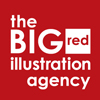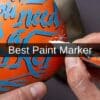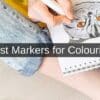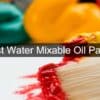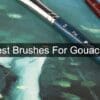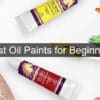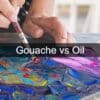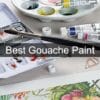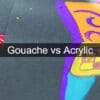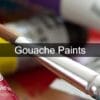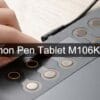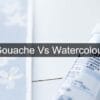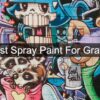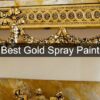Gouache Vs Watercolour
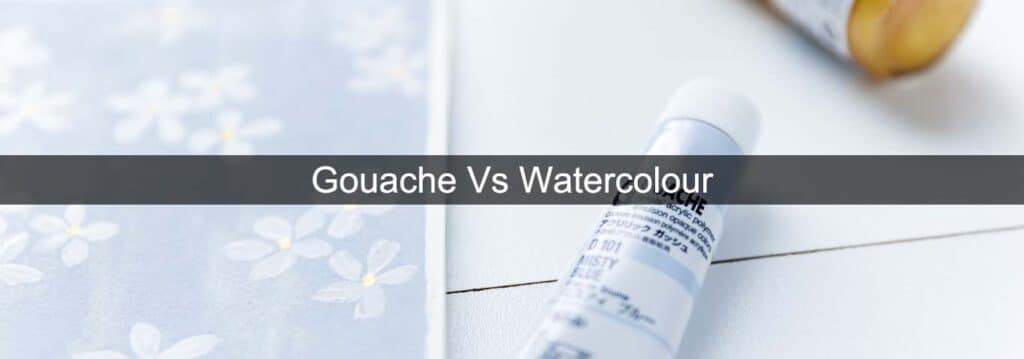
There is a wide range of water-soluble paints. Watercolor paints and gouache paints are among the most popular water-soluble paint options. They are super fun to work with, especially because of their convenience and availability.
Gouache paint has the best texture in terms of application which is why a lot of people prefer gouache paint over watercolor paint.
However, there are a handful of people who prefer the former for many reasons. Even though they might both be water-soluble, they have their discernable differences which make people pick one or the other.
This body of text will discuss the main differences between gouache paints and watercolor paints and why some may prefer one over the other.
Gouache

While watercolor paints generally can be thinned using water and the end application is easily made translucent upon application, gouache paint on the other hand is quite thick in terms of consistency. They are not so easily made runny or translucent.
The finish from gouache paint is way more dense and opaque. Means they aren’t that great if you want to do small detailed work on your paint projects. The finish of gouache paints on watercolor paper is quite similar to what you would find in the end results of matte acrylic paint.
Gouache watercolor can be used on watercolor paper or most surfaces you might want to apply paint on. Gouache is naturally opaque and creates spectacular luminosity due to the final finish and thickness of the paint. On watercolor paper, if you allow the paint to dry completely it makes gouache opaque and gives it an incredible matte finish that has a lot of vibrancies.
You can mix gouache paints with watercolor to have a mix between the two in tandem as both watercolor and gouache go hand in hand. Some might say gouache is just opaque watercolor. However, the thickness and consistency are similar to oil paint but it dries completely upon application.
If you’re not a fan of transparent watercolors you can manipulate gouache paint on a watercolor painting to acquire your desired effects. Gouache paintings turn out to be large bold colors on a canvas.
You can try out a variety of techniques while working with gouache paints, you can go from the wet-on-wet technique to the staining technique for your painting. Gouache sits great on paper and makes it opaque so you can easily use gouache for a big backdrop for your paintings.
You can use gouache around colorful shapes to create blurred edges or shapes which is a very common technique to make your painting pop. You always have the option to rewet gouache which allows you to modify further once even after it is set on paper.
Traditional gouache is used very differently and since there are a lot of gouache characteristics there are a variety of techniques to try on your paintings. They are great as water-soluble pigments and also incredible for mixed media work which is why a lot of people choose gouache over traditional transparent watercolor or acrylic paints.
Gouache colors are beautifully vibrant and when they dry completely you can use other mediums such as acrylic medium to work together for your paintings. But in hindsight, the opaqueness makes gouache great when you let it dry completely.
If you are trying to make your gouache lighter, you can simply add extra water which will then create more space between the big pigment particles to make the gouache transparent.
Artists when referring to opaque watercolor automatically assume that gouache is being mentioned as the key distinction between watercolor and gouache is the opaqueness. Additionally, it is not often but it can also be mentioned in particular watercolor pigments such as cadmium which are preliminarily opaque.
Artists often use the word opaque watercolor to refer to particular watercolor pigments such as either cadmium or gouache. A key difference to remember while making a distinction is that acrylic gouache is not the same as normal gouache. Acrylic gouache dries into a plastic that cannot be rewet or modified once set as acrylic paints is usually color particles suspended in polymer.
Gouache is made opaque because of the white pigment or white chalk additive. These additives make the particles of paint pack closer together thus not allowing much light to pass through. On white paper for example if you apply gouache alongside watercolor you will see the difference in light passing through the paper.
Gouaches use gum arabic as a binder on better quality products, however, cheaper paints use a different binder which doesn’t really compromise the integrity of the paint.
While the opaqueness of gouaches is a very strong paint, that same quality makes gouache terrible for detailed work since you are working with such a heavy medium.
Watercolor paints

Transparent watercolor and gouache’s main key difference is the consistency and the finish. For transparent pigments, transparent watercolors can do the trick with a little bit of water.
Acrylic paints are set right between transparent watercolors and gouache. Gouache is opaque watercolor whereas watercolor paint is just more translucent.
Watercolor paints allow easier brush strokes for their inherently light nature. Watercolor paint consists of color particles suspended in a medium as do all mediums of paint.
You can easily use the same paper and brushes for both watercolor and gouache as any surface suitable for a watercolor medium. If transparent washes are more your style, you can simply add more water to gouache. It works for both gouache and watercolor.
For a lighter color, however, or lighter colors as a matter of fact, watercolor is the easiest paint to work with. You get a translucent finish as opposed to an almost completely opaque gouache paint.
Watercolor pigments contain tiny particles of paint particles that are not fully packed together which allows light to pass through making them translucent. On the other hand for gouaches, the tightly packed particles leave less space for light to pass through.
While some people may argue watercolor is a totally separate media from gouaches they have some similarities since the same brush and the papers can be used for their work. The two can work with each other as if you paint light on dark pigment transparent, the light colors will be visible. Transparent watercolorists prefer watercolor paint over anything else for this very reason.
With gouache and watercolor paint, you can achieve results you normally would not be able to get with conventional methods of layering light colors over a dark background.
You can freely use watercolor brushes in both watercolor and gouache. This is one advantage you can easily work with all that you already have from the art store.
Techniques for watercolor and gouache
There are a few tips and suggestions that you can derive from any good watercolor artist magazine as they have seasoned artists curated to let the readers and painting enthusiasts know about various techniques to try out for the masses.
Gouache and watercolor are two of the most popular media of paint in the art industry and thus you will find information and tips and tricks on them almost anywhere.
If you are not a stickler for the whole opaqueness business, you are free to work with media. By adding white gouache paint to your conventional you can easily achieve the effect of a more opaque painting in your watercolors.
Donna Zagotta is a beacon of inspiration for many artists all across the globe. She has curated herself a magnificent portfolio and has spoken about her techniques with watercolor and gouaches in great detail. She mainly does impasto paintings which indicates the influence of dark paint in the work.
The way she achieves these brilliant results in her primarily watercolor paintings is that she adds white gouache paint to her transparent watercolors to achieve the results of a gouache painting.
If you are a stickler for impasto paintings, her work is a must-see for any up-and-coming artist or even seasoned artist.
Another artist in the industry is artist Carla O’Connor, upon first glance at her gallery or portfolio you can easily identify that she works with opaque paints. Gouaches to be more specific, upon the first look, you can see how deep her paints stain on the surfaces she draws on.
She reports that gouaches are her favorite water media as she absolutely adores the textures she achieves from the paints. She has a palette dedicated to gouache grays in her work as you can see from the washed-out colors in her work.
You can see artists like Sarkis Antikajian use gouache for his Plein air kit to take them on the go wherever he wants with ease. You can easily see in his paintings the effects of darker paints like gouaches and the heavy influence of them on the colors.
People may often confuse Gouache’s colors with egg tempera as it is a very similar media and consistency of paint for artists to use.
However, egg tempera is used primarily in posters so take that with a grain of salt. It’s not a very popular media of paint to begin within the watercolor industry.
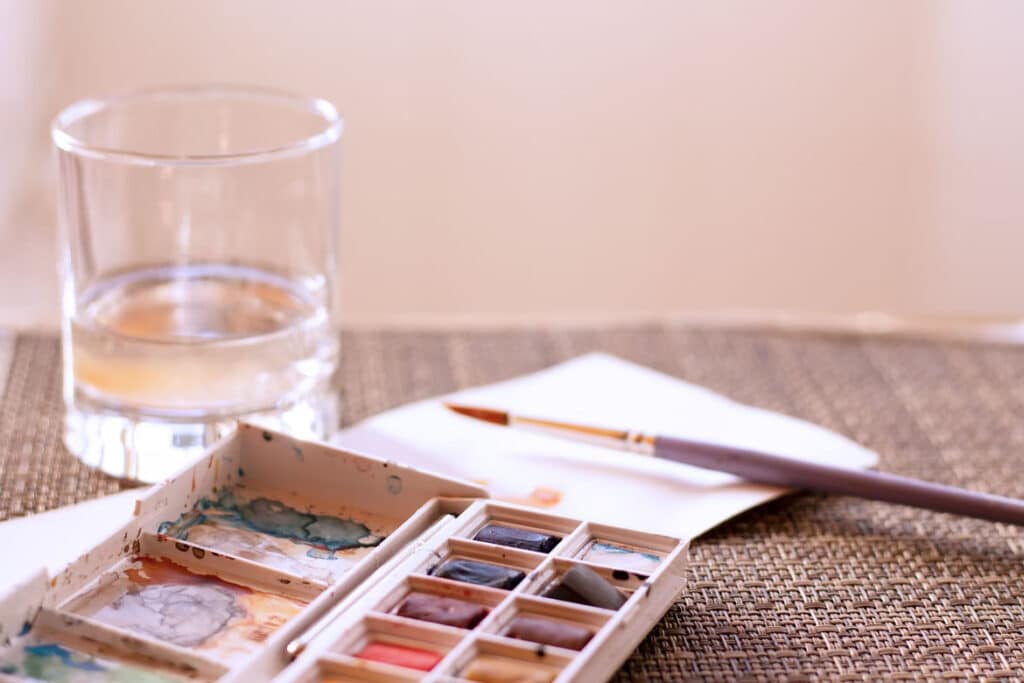
FAQs
Can I use gouache as watercolor?
Gouaches are super easy to identify with their consistency and application results. They leave a dark and thicker stain as opposed to watercolors, however, you are free to add extra water to this water-soluble medium of paint to achieve results similar to watercolor.
To do the same to the former, you simply add a little bit of white gouache color to achieve the results of a gouache finish.
In the battle of gouache vs watercolor, it’s evident that you do not have to pick the latter or the former, you may simply use both in harmony without any compromises.
It is only a matter of preference.
Do professional artists use gouaches?
The pros prefer gouache’s versatility. You have seen above in the section about tips and tricks for watercolors and gouaches that gouache has the ability to be reworked and rewetted.
This feature is sought out by many artists in the industry and amongst hobby painters.
Affiliate Disclosure
In compliance with the FTC guidelines, please assume the following about all links, posts, photos and other material on this website: Any/all of the links on this website are affiliate links of which The Big Red Illustration Agency receives a small commission from sales of certain items, but the price is the same for you. www.bigredillustrationagency.com is a participant in the Amazon Services LLC Associates Program, an affiliate advertising program designed to provide a means for sites to earn advertising fees by advertising and linking to Amazon.com & Amazon.co.uk. Pages on this site may include links to Amazon and its affiliate sites on which the owner of this website will make a referral commission.
FULL TERMS HERE Cookie preferences: cookie preferences
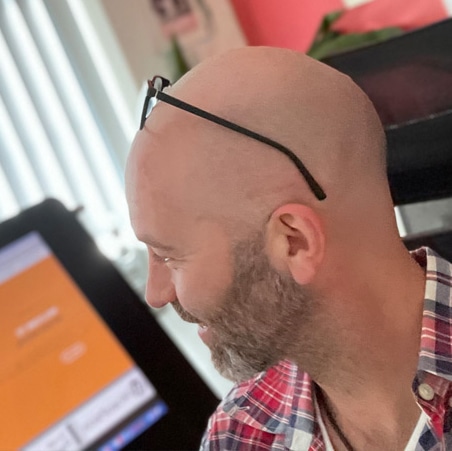
Written By Adam Rushton
Adam has made a name for himself in the illustration industry and is a passionate blogger and writer on the subject of art, illustration and graphic design.
His artwork has been featured in countless publications and used for very well-known media projects. As a professional illustrator for over 20 years, Adams media outlets, a wealth of knowledge, and experience enable him to consult and advise artists and illustrators in this country (from York and Manchester to Southampton and London) and all over the world.
